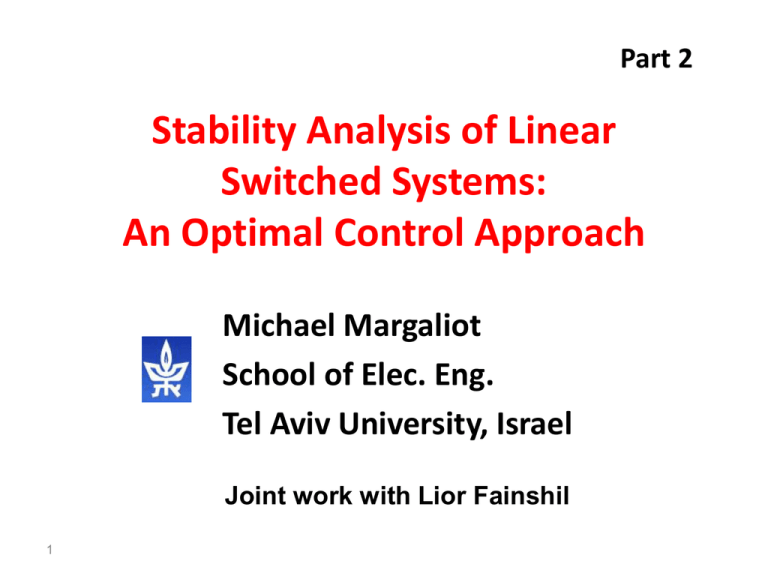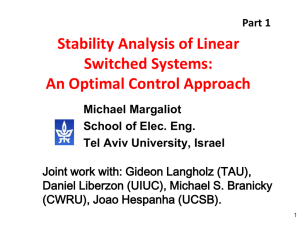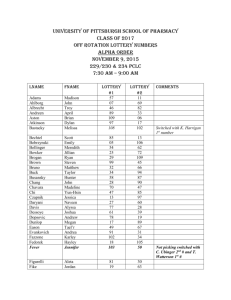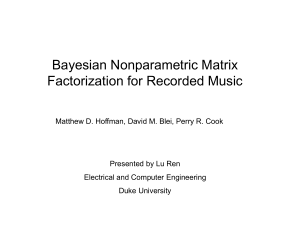Part 2
advertisement

Part 2
Stability Analysis of Linear
Switched Systems:
An Optimal Control Approach
Michael Margaliot
School of Elec. Eng.
Tel Aviv University, Israel
Joint work with Lior Fainshil
1
Outline
• Positive linear switched systems
• Variational approach
■ Relaxation: a positive bilinear control
system
■ Maximizing the spectral radius of the
transition matrix
■ Main result: a maximum principle
■ Applications
2
Linear Switched Systems
Two (or more) linear systems:
x(t ) A1 x(t ),
x(t ) A2 x(t ).
A system that can switch between them:
x(t ) Aσ (t ) x(t ),
σ : R {1,2}.
Global Uniform Asymptotic Stability (GUAS):
x(t ) 0,
x(0), σ .
AKA, “stability under arbitrary switching”.
4
Why is the GUAS problem difficult?
1. The number of possible switching laws is
huge.
5
Why is the GUAS problem difficult?
2. Even if each linear subsystem is stable, the
switched system may not be GUAS.
0 1
x
x
2 1
6
0 1
x
x
12 1
Why is the GUAS problem difficult?
2. Even if each linear subsystem is stable, the
switched system may not be GUAS.
7
Variational Approach
Pioneered by E. S. Pyatnitsky (1970s).
Basic idea:
(1) relaxation: linear switched system →
bilinear control system
(2) characterize the “most destabilizing
control” u *
(3) the switched system is GUAS iff x * (t ) 0
8
Variational Approach for Positive
Linear Switched Systems
Basic idea:
(1) positive linear switched system →
positive bilinear control system (PBCS)
(2) characterize the “most destabilizing
control” u *
9
Positive Linear Systems
Motivation: suppose that the state
variables can never attain negative values.
x(0) 0
x(t ) 0, t 0.
In a linear system x Ax, this holds if
aij 0, i j.
i.e., off-diagonal entries are non-negative.
10
Such a matrix is called a Metzler matrix.
Positive Linear Systems
x Ax,
with aij 0, i j.
Theorem x(0) 0 x(t ) 0, t 0.
An example:
1 3
x
x
5 2
x1 x1 a non-negative number
x1 0 0, x2 0 0 x1 (t ) 0, t 0.
11
Positive Linear Systems
The solution of x Ax is x(t ) exp( At ) x(0).
transition matrix
If A is Metzler then for any t 0
exp( At ) : Rn Rn
so exp( At ) 0.
12
The transition matrix is a non-negative
matrix.
Perron-Frobenius Theory
Definition Spectral radius of a matrix C
ρ(C ) max{| λ |: λ eig(C )}.
Example Let
0 1
C
.
1 0
The eigenvalues are λ1 j, λ2 j,
so
ρ(C ) max{| λ1 |,| λ2 |} 1.
13
Perron-Frobenius Theorem
Theorem Suppose that C 0.
• C has a real eigenvalue λmax such that:
λmax ρ(C ) : max{| λ |: λ eig(C )}
ρ(C ').
• The corresponding eigenvectors of
C, C ' , denoted v, w, satisfy v 0, w 0.
14
Positive Linear Switched Systems:
A Variational Approach
Relaxation: x A Bu x, u U .
“Most destabilizing control”: maximize the
spectral radius of the transition matrix.
17
Positive Linear Switched Systems:
A variational Approach
x A Bu x.
Theorem For any T>0, x(T ; u ) C (T ; u ) x(0)
where C (T ; u ) is the solution at time T of
C t A Bu t C t ,
C 0 I .
C is called the transition matrix
corresponding to u.
18
Transition Matrix of a Positive System
x(T ; u ) C (T ; u ) x(0)
C t A Bu t C t ,
C 0 I .
If A1 , A2 are Metzler, then C (t ) 0, t 0.
C (T ) and C '(T ) admit a real and
eigenvalue λ(T ) such that:
λ(T ) ρ(C (T )) ρ(C '(T )).
19
The corresponding eigenvectors
satisfy v 0, w 0.
Optimal Control Problem
C t A Bu t C t ,
C 0 I .
Fix an arbitrary T>0.
Problem: find a control u* U that
maximizes ρ(C (T , u )).
We refer to u * as the “most destabilizing”
control.
20
Relation to Stability
C t A Bu t C t ,
C 0 I .
Define:
ρT ( A, B) max uU (C (T , u )) .
1/T
ρ( A, B) limsupT ρT ( A, B).
Theorem: the PBCS is GAS if and only if
ρ( A, B ) 1.
21
Main Result: A Maximum Principle
Theorem Fix T>0. Consider
C t A Bu t C t , C 0 I .
Let u * be optimal. Let C* C (T , u*),
and let v*, w * denote the factors of C *.
Define
p A Bu * p,
p 0 v*,
q A Bu * ' q, q 0 w*,
and let m(t ) q ' t Bp t .
Then
1, m(t ) 0,
22
u *(t )
0, m(t ) 0.
Comments on the Main Result
p A Bu * p,
p 0 v*,
q A Bu * ' q, q 0 w*,
m(t ) q ' t Bp t .
1, m(t ) 0,
u *(t )
0, m(t ) 0.
23
1. Similar to the Pontryagin MP, but with
one-point boundary conditions;
2. The unknown v*, w * play an important
role.
Comments on the Main Result
p A Bu * p,
p 0 v*,
q A Bu * ' q, q 0 w*,
m(t ) q ' t Bp t .
3. The switching function satisfies:
m(T ) q ' T Bp T
q '(T ) BC *(T ) p 0
(q ' 0 / λ ) Bλ p 0
max
q ' 0 Bp 0
m(0).
24
max
Comments on the Main Result
m(T ) m(0).
m (t )
0 t1
t2
t3
t4 T
t
The number of switching points in a bangbang control must be even.
25
Main Result: Sketch of Proof
Let u* U be optimal. Introduce a needle
variation u with perturbation width ε 0.
Let C denote the corresponding transition
matrix.
u *(t )
1
0
u (t )
1
0
T
t
0
0
ε
By optimality, ρ(C (T )) ρ(C * (T )).
26
T
t
Sketch of Proof
Let γ ε ρ C T . Then γ 0 ρ C * T ρ *.
We know that
γ ε γ 0 εγ 0 ...
with
d
γ 0 w * ' C T v *.
dε
ε 0
Since u * is optimal, γ 0 ρ* γ ε , so
d
w * ' C T v* 0
ε 0
dε
27
Sketch of Proof
Since u * is optimal, γ 0 ρ* γ ε , so
d
w * ' C T v* 0.
ε 0
dε
We can obtain an expression for
C (T ) C * (T )
to first order in ε, as u is a needle variation.
28
Applications of Main Result
Assumptions: A1 , A2 R
nn
are Metzler
kA1 (1 k ) A2 is Hurwitz k [0,1].
Proposition 1 If there exist α, β R such that
αA1 βA2 0, the switched system is GUAS.
Proposition 2 If A2 A1 bc ' and either b 0
or c 0, the switched system is GUAS.
29
Applications of Main Result
Assumptions: A1 , A2 R
nn
are Metzler
kA1 (1 k ) A2 is Hurwitz k [0,1].
Proposition 3 If A2 A1 bc ' then any
bang-bang control with more than one
switch includes at least 4 switches.
Conjecture If A2 A1 bc ' then the
switched system is GUAS.
30
Conclusions
We considered the stability of positive
switched linear systems using a variational
approach.
The main result is a new MP for the control
maximizing the spectral radius of the
transition matrix.
31
Further research: numerical algorithms for
calculating the optimal control; consensus
problems; switched monotone control
systems,…
More Information
Margaliot. “Stability analysis of switched systems
using variational principles: an introduction”,
Automatica, 42: 2059-2077, 2006.
Fainshil & Margaliot. “Stability analysis of positive
linear switched systems: a variational
approach”, submitted.
Available online:
www.eng.tau.ac.il/~michaelm
32









